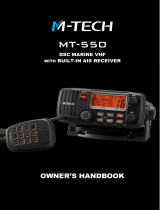Page is loading ...

MATRIX SERIES
GX2000 and GX2150
25 Watt VHF/FM
Marine Transceivers
Owner's Manual
GX2000: AIS support with external AIS receiver or transponder
GX2150:IntegrateddualchannelAIS(AutomaticIdenticationSystem)receiver
GX2150: 4800 or 38400 NMEA baud rate selection for plotters with 1 NMEA port
GX2150:AbletousePAorFogsignalingwhenonAISdisplay
TrueandMagneticbearingselectiononAISdisplay
AIStargetdisplayincludesMMSI,Callsign,ShipName,BRG,DST,SOG&COG
ContactClassAorBAISShipwithDSC
ProgrammableCPAorTCPAcollisionavoidancealarms
ITUClassDDSC(IndependentChannel70receiverbuilt-in)
Navigationinformation(LAT/LONG,SOG,COG)informationshownondisplay
NavigatetoaDSCDistressPosition
Enter,SaveandNavigatetoawaypointwithcompasspage
80dBcommercialgradereceiver
AutomaticDSCPositionPollrequesttoupto4separatevessels
E2O(Easytooperate)menusystemwithuserprogrammablesoftkeysonradio
GPSCompass,WaypointandGPSstatuspages
SubmersibleJIS-7/IPX-7rating(3.3feetfor30mins)
GX2150: 30WattPA/Loudhailerwithpreprogrammedfog signals andlisten-back
facility
ClearVoicenoisecancellingmicrophonewithchannelselectorand16/9key
CapableofconnectingtoaSecondStationRemote-AccessMicrophoneCMP31
IntercombetweenradioandRAM3+microphone
Versatileuser-programmablescanning,priorityscanandDualWatch
OversizedrotaryCHknobwithpushtoenter,backlitdisplayandkeys
VoiceScrambler(optional)
Local/Distanceattenuator
GX2150requiresconnectiontoexternalGPSor
GX2000requiresconnectiontoexternalGPSandAISreceiverortransponder
MATRIX AIS+ GX2150MATRIX GX2000

Page 2
GX2000/GX2150
TABLE OF CONTENTS
Quick Reference Guide ............................................................................... 4
1 GENERAL INFORMATION .....................................................................5
2 PACKING LIST .......................................................................................6
3 OPTIONAL ACCESSORIES ...................................................................6
4 ONLINE WARRANTY REGISTRATION (in USA or Canada only) ....... 6
5 GETTING STARTED...............................................................................7
5.1 PROHIBITED COMMUNICATIONS ............................................. 7
5.2 ABOUT VHF RADIO ....................................................................7
5.3 SELECTING AN ANTENNA .........................................................7
5.4 COAXIAL CABLE .........................................................................8
5.5 DISTRESS AND HAILING (CHANNEL 16) ..................................8
5.6 CALLING ANOTHER VESSEL (CHANNEL 16 OR 9)..................9
5.7 MAKING TELEPHONE CALLS ..................................................10
5.8 BRIDGE CHANNELS 13 AND 67 ..............................................10
5.9 AUTOMATED RADIO CHECK SERVICE ............................... 11
5.10 WHAT IS THE RANGE FOR AIS RECEIVERS? .......................12
6 INSTALLATION ....................................................................................13
6.1 SAFETY / WARNING INFORMATION ....................................... 13
6.2 LOCATION ................................................................................. 13
6.3 MOUNTING THE RADIO ........................................................... 14
6.3.1 Supplied Mounting Bracket ..............................................14
6.3.2 Optional MMB-84 Flush Mount Bracket ...........................15
6.4 ELECTRICAL CONNECTIONS .................................................16
6.5 ACCESSORY CABLES .............................................................17
6.5.1 MATRIX GX2000 Connection ..........................................17
6.5.2 MATRIX AIS+ GX2150 Connection ..................................20
6.6 CHECKING GPS CONNECTIONS ............................................ 23
6.7 CHANGING THE GPS TIME .....................................................23
6.8 CHANGING THE TIME LOCATION ...........................................24
6.9 CHANGING THE TIME FORMAT ..............................................24
6.10 CHANGING COG TO TRUE OR MAGNETIC ..........................25
6.11 OPTIONAL CMP31
(
RAM3+
)
INSTALLATION .......................... 25
6.11.1 Connecting an External Speaker to the RAM3+ Mic
Cable .............................................................................27
6.11.2 External Speaker AF Selection ......................................27
7 CONTROLS AND INDICATORS ..........................................................28
7.1 FRONT PANEL ..........................................................................28
7.2 REAR PANEL .............................................................................30
7.3 MICROPHONE ..........................................................................32
8 BASIC OPERATION ............................................................................. 33
8.1 RECEPTION ..............................................................................33
8.2 TRANSMISSION ........................................................................ 33
8.3 TRANSMIT TIME - OUT TIMER (TOT) ......................................33
8.4 SIMPLEX/DUPLEX CHANNEL USE ..........................................34
8.5 DISPLAY TYPE ..........................................................................34
8.6 USA, INTERNATIONAL, AND CANADA MODE ........................35
8.7 NOAA WEATHER CHANNELS .................................................. 35
8.7.1 NOAA Weather Alert ........................................................35
8.7.2 NOAA Weather Alert Testing ............................................36
8.8 DUAL WATCH (TO CHANNEL 16) ............................................36
8.9 SCANNING ................................................................................37
8.9.1 Selecting the Scan Type ..................................................37
8.9.2 Programming Scan Memory ............................................38
8.9.3 Memory Scanning (M-SCAN) ..........................................38
8.9.4 Priority Scanning (P-SCAN) ............................................. 39
8.10 PRESET CHANNELS
(
0 ~ 9
)
: INSTANT ACCESS ...................39
8.10.1 Programming .................................................................39
8.10.2 Operation .......................................................................40
8.10.3 Deletion .......................................................................... 40
8.11 PA/FOG OPERATION ................................................................ 41
8.11.1 Operating the PA HAIL mode .........................................41
8.11.2 Operating the FOG HORN mode ...................................42
8.11.3 Fog Signal Timing Chart .................................................43
8.12 INTERCOM OPERATION .......................................................... 44
8.12.1 Communication ..............................................................44
8.12.2 Calling ............................................................................44
8.13 VOICE SCRAMBLER ................................................................45
8.14 DEMO MODE ............................................................................46
9 DIGITAL SELECTIVE CALLING (DSC) ...............................................47
9.1 GENERAL ..................................................................................47
9.2 MARITIME MOBILE SERVICE IDENTITY (MMSI) ....................47
9.2.1 What is an MMSI? ............................................................ 47
9.2.2 Programming the MMSI ....................................................48
9.3 DSC DISTRESS CALL...............................................................49
9.3.1 Transmitting a DSC Distress Call ..................................... 49
9.3.2 Receiving a DSC Distress Call ........................................52
9.4 ALL SHIPS CALL .......................................................................54
9.4.1 Transmitting an All Ships Call ..........................................54
9.4.2 Receiving an All Ships Call ..............................................55
9.5 INDIVIDUAL CALL .....................................................................56
9.5.1 Setting up the Individual / Position Call Directory ............56
9.5.2 Setting up the Individual Call Reply .................................57
9.5.3 Enabling the Individual Call Acknowledgment .................58
9.5.4 Transmitting an Individual Call .........................................58
9.5.5 Receiving an Individual Call ............................................. 60
9.5.6 Setting up the Individual Call Ringer ................................ 61
9.6 GROUP CALL ............................................................................63
9.6.1 Setting up a Group Call .................................................... 63
9.6.2 Transmitting a Group Call ................................................65
9.6.3 Receiving a Group Call ....................................................67
9.6.4 Setting up the Group Call Ringer .....................................68
9.7 POSITION REQUEST ...............................................................69
9.7.1 Setting up a Position Request Reply ..............................69
9.7.2 Transmitting a Position Request to Another Vessel .........70
9.7.3 Receiving a Position Request ..........................................71
9.7.4 Setting up a Position Request Ringer ..............................72
9.8 POSITION REPORT ..................................................................73
9.8.1 Transmitting a DSC Position Report Call .........................73
9.8.2 Receiving a DSC Position Report Call ............................. 74
9.8.3 Navigating to a Position Report .......................................75
9.8.4 Stopping Navigation to a Position Report ........................75
9.8.5 Saving a Position Report as a Waypoint ..........................76
9.8.6 Navigating to a Saved Waypoint ......................................76
9.8.7 Setting up a Position Report Ringer ................................. 77
9.9 MANUAL INPUT OF A GPS LOCATION (LAT/LON) ..................78
9.10 AUTO POS POLLING ................................................................79
9.10.1 Setting up the Polling Time Interval ...............................79
9.10.2 Selecting Stations to be Automatically Polled (Tracked) 79
9.10.3 Enabling/Disabling Auto POS Polling ............................ 80
9.11 DSC TEST .................................................................................81
9.11.1 Programming MMSI into Individual Directory ................. 81
9.11.2 DSC Test call by using Individual/Position Directory ......81
9.11.3 DSC Test Call by Manually Entering an MMSI ...............82
9.12 POLLING CALL..........................................................................83
9.12.1 Transmitting a Polling Call to Another Vessel ................83
9.12.2 Receiving a Polling Call .................................................84
9.13 DSC LOG OPERATION ............................................................. 85
9.13.1 Reviewing and Resending a Transmitted Logged Call ..85
9.13.2 Reviewing a Logged DSC Distress Call ......................... 86
9.13.3 Reviewing Other Logged Calls ......................................87
9.13.4 Deleting a Call from the DSC Log Directory ..................87
10 GENERAL SETUP ................................................................................89
10.1 DISPLAY ....................................................................................89
10.2 LOCAL DISTANCE RECEIVER ATTENUATOR ........................89

Page 3
GX2000/GX2150
TABLE OF CONTENTS
10.3 DIMMER ADJUSTMENT............................................................90
10.4 DISPLAY CONTRAST ...............................................................90
10.5 TIME OFFSET ...........................................................................91
10.6 TIME AREA ................................................................................91
10.7 TIME DISPLAY...........................................................................91
10.8 UNIT OF MEASURE ..................................................................91
10.9 MAGNETIC ................................................................................92
10.10 NMEA DATA IN/OUT ..................................................................92
10.11 KEY BEEP .................................................................................93
10.12 FOG ALERT TONE FREQUENCY.............................................93
10.13 STATION NAME.........................................................................94
10.14 SOFT KEYS ...............................................................................95
11 CHANNEL FUNCTION SETUP ............................................................97
11.1 CHANNEL GROUP .................................................................... 97
11.2 SCAN MEMORY ........................................................................97
11.3 SCAN TYPE ............................................................................... 97
11.4 SCAN RESUME ......................................................................... 97
11.5 PRIORITY CHANNEL ................................................................98
11.6 WEATHER ALERT .....................................................................98
11.7 CHANNEL NAME.......................................................................99
11.8 SCRAMBLER SETUP ..............................................................100
12 DSC SETUP ........................................................................................ 101
12.1 INDIVIDUAL DIRECTORY .......................................................101
12.2 INDIVIDUAL REPLY ................................................................101
12.3 INDIVIDUAL ACKNOWLEDGMENT ........................................101
12.4 INDIVIDUAL RINGER ..............................................................101
12.5 GROUP DIRECTORY ..............................................................101
12.6 POSITION REPLY ...................................................................102
12.7 DSC BEEP ...............................................................................102
12.8 AUTO CHANNEL SWITCH TIME ............................................103
12.9 NO ACTION TIMER ON MENU OPERATION .........................103
12.10 NO ACTION TIMER ON DSC OPERATION ............................104
12.11 NO ACTION TIMER ON DISTRESS OPERATION ..................104
13 AUTOMATIC IDENTIFICATION SYSTEM (AIS) ................................105
13.1 GENERAL ................................................................................105
13.2 AIS OPERATION .....................................................................106
13.2.1 AIS Range ...................................................................107
13.2.2 Transmitting an Individual Call to an AIS Ship .............107
13.2.3 Receiving an AIS-SART Signal ....................................108
13.3 AIS/COMPASS SETUP............................................................109
13.3.1 Direction ......................................................................109
13.3.2 Activation Range .........................................................109
13.3.3 CPA Alarm....................................................................110
13.3.4 TCPA Alarm ................................................................. 111
13.3.5 Display Range .............................................................112
14 WAYPOINTS ....................................................................................... 113
14.1 MARKING A POSITION ........................................................... 113
14.2 ADDING A WAYPOINT ............................................................114
14.3 EDITING A WAYPOINT ............................................................115
14.4 DELETING A WAYPOINT ........................................................116
14.5 SAVING A DSC POSITION CALL AS A WAYPOINT ................116
14.6 NAVIGATING TO A SAVED WAYPOINT .................................. 116
14.7 STOPPING NAVIGATION TO A WAYPOINT ...........................117
14.8 SELECTING THE WAYPOINT RANGE ................................... 117
15 CMP31
(
RAM3+
)
REMOTE MIC OPERATION .................................. 118
15.1 REMOTE MIC CONTROLS ..................................................... 118
15.2 ASSIGNING SOFT KEYS ........................................................120
16 MAINTENANCE ..................................................................................122
16.1 REPLACEMENT PARTS .........................................................122
16.2 FACTORY SERVICE ...............................................................123
16.3 TROUBLESHOOTING CHART ................................................124
17 CHANNEL ASSIGNMENTS................................................................125
18 WARRANTY........................................................................................131
19 RESET PROCEDURES ...................................................................... 135
19.1 MEMORY CLEAR ....................................................................135
19.2 MICROPROCESSOR RESETTING ........................................135
20 SPECIFICATIONS ..............................................................................136
20.1 GENERAL .................................................................................136
20.2 TRANSMITTER ......................................................................... 136
20.3 RECEIVER (for Voice and DSC) ...............................................137
20.4 RECEIVER (for AIS) .................................................................. 137
20.5 NMEA INPUT/OUTPUT .............................................................138
20.6 DIMENSIONS ............................................................................139
21 FCC RADIO LICENSE INFORMATION ..............................................140
21.1 STATION LICENSE..................................................................140
21.2 RADIO CALL SIGN ..................................................................140
21.3 CANADIAN SHIP STATION LICENSING ................................. 140
21.4 FCC / INDUSTRY CANADA INFORMATION ........................... 140
22 FCC NOTICE ......................................................................................141

Page 4
GX2000/GX2150
Quick RefeRence Guide
The GX2000 and GX2150 areequippedwiththeE2O(Easy-To-Operate)
system. Basicoperation may beaccomplished by following the procedure
below:
Press and hold the PWR/VOLknobtoturnonorofftheradio.
RotatethePWR/VOLknobtoadjustthespeakeraudiovolume.
RotatetheCHknob(orpressthemicrophone’s /
keys)toselect
theoperatingchannel.
Move the SQLknobclockwisetosquelchorcounterclockwiseto
un-squelchtheradio.
Press the
H / L
keytotogglethetransmitpowerbetweenHigh(25W)
andLow(1W).
Press the
9
16
keyontheradioorthemicrophonetoselectchannel16.
Press and hold the
9
16
keyon theradio orthe microphoneto select
channel9.Pressagaintoreverttothelastselectedchannel.
To transmit: place your mouth about 1/2 inch away from Mic hole and
speakinanormalvoicelevelwhilepressingthePTTswitch.
MiC HoLe

Page 5
GX2000/GX2150
1 GENERAL INFORMATION
TheSTANDARD HORIZONMATRIXSeries GX2000 and GX2150 Marine
VHF/FMMarinetransceiveraredesignedtobeusedinUSA, International,
andCanadianMarinebands.TheGX2000 and GX2150 can be operated from
11to16VDCandhaveaswitchableRFoutputpowerof1wattor25watts.
MATRIX AIS+ GX2150
Integratesa dual channelAIS (Automatic Identication System) receiverto
displayAIS vesselinformation(MMSI, Call Sign,ShipName, BRG, DST,
SOGandCOG)directlyontheVHFradio,soyouwillknowwhatisoutthere
inanyconditions.TheGX2150 is also capable of entering and saving up to
100waypoints,whichmaybeselectedandnavigatedtobyusingaunique
navigationcompassdisplay.TheMATRIXAIS+allowsyoutocontactanAIS
ShipdirectlyusingDSC,showyourvesselspositioninrelationtoAIStargets
andalertyouwhenanAISshipmaybeapproachingtooclosetoyourloca-
tionvia the ClosestPointofApproach(CPA)Alarm.ToreceiveAIStargets
from ships withAIS classA or B transponders, simply connect the normal
VHFantenna(onlyoneantennaneeded!)andaGPSwithNMEA0183ouut-
put.
MATRIX GX2000
ForthemarinerwhoalreadyhasAISon-boardanddesiresaVHFwiththe
featuresoftheMATRIXAIS,theMATRIXGX2000 has a connection for an
AISreceiverortransponder.
TheMATRIXSeriesVHFsarecapableofDSC(DigitalSelectiveCalling)ITU
ClassDoperation.ClassDoperationallowscontinuousreceivingofDigital
SelectiveCallingfunctionsonchannel70eveniftheradioisreceivingacall.
The MATRIX Series VHF’s operate on all currently-allocated marine chan-
nelswhichareswitchableforusewithUSA,International,orCanadianregu-
lations.Emergencychannel16canbeimmediatelyselectedfromanychan-
nelbypressingthered
9
16
key.NOAAweatherchannelcanalsobe
accessedimmediatelybypressingandholdingthe
CLR
WX
key.
Other features of the MATRIX Series VHF’s include: Speaker Microphone,
30WPA/Fog,optionalRAM3+ secondstationremote-control microphone
withAISdisplay,intercombetween radioand optional RAM3+,scanning,
priority scanning,submersible speaker mic, high and low voltage warning,
andGPSrepeatability.

Page6
GX2000/GX2150
2 PACKING LIST
Whenthepackagecontainingthetransceiverisrstopened,pleasecheckit
for the following contents:
GX2000 or GX2150 Transceiver
PowerCord
MountingBracketandHardware
Owner’sManual
DSCWarningSticker
Flush Mount Template
3 OPTIONAL ACCESSORIES
MMB-84 ..........................................................................Flush-MountBracket
CMP31B/W ..............Remote-AccessMicrophone(RAM3+Mic,Black/White)
CT-100 .............................................23FeetExtensionCableforRAM3+Mic
CVS2500 ...............................................................................VoiceScrambler
MLS-310 ............ 10WampliedExternalSpeakerwithon/offVolumecontrol
MLS-300 ..................................................................... ExternalLoudSpeaker
220SW ............................................................5”Round30WattHail/PAHorn
240SW ............................................5”x8”Rectangular40WattHail/PAHorn
HC2000 ............................................................................ DustCover(White)
Q7000619A ..............................ExternalGPSAntennawith30FeetofCable
4 ONLINE WARRANTY REGISTRATION
(in USA or Canada only)
Pleasevisitwww.standardhorizon.comtoregistertheGX2000/GX2150
Marine VHF. It should benoted that visiting the website from time to time
maybebenecialtoyou,asnewproductsarereleasedtheywillappearon
theSTANDARDHORIZONwebsite.
PRODUCT SUPPORT INQUIRIES
If youhave any questions or comments regarding theuse of the GX2000/
GX2150,youcanvisittheSTANDARDHORIZONwebsitetosendanE-Mail
orcontacttheProductSupportteamat(800)767-2450M-F8:00-5:00PST.

Page7
GX2000/GX2150
5 GETTING STARTED
5.1 PROHIBITED COMMUNICATIONS
TheFCCprohibitsthefollowingcommunications:
• Falsedistressoremergencymessages:
• Messagesto“anyboat”exceptinemergenciesandradiotests;
• Messagestoorfromavesselonland;
• Transmissionwhileonland;
• Obscene,indecent,orprofanelanguage(potentialneof$10,000).
5.2 ABOUT VHF RADIO
The radiofrequencies used in theVHF marine band liebetween 156 and
158MHzwithsomeshorestationsavailablebetween161and163MHz.The
marineVHFbandprovidescommunicationsoverdistancesthatareessen-
tially“lineofsight”(VHFsignals do nottravel wellthrough objectssuchas
buildings,hillsor trees).Actualtransmissionrangedependsmuchmoreon
antenna type, gain andheight thanon the power output ofthe transmitter.
Onaxedmount25Wradiotransmissionexpecteddistancescanbegreater
than 15 miles, for a portable 5W radio transmission the expecteddistance
canbegreaterthan5milesin“lineofsight”.
5.3 SELECTING AN ANTENNA
Marineantennasaremadetoradiatesignalsequallyinallhorizontaldirec-
tions,butnot straight up.The objectiveofamarine antenna istoenhance
thesignal towardthehorizon.The degreetowhich thisis accomplished is
calledtheantenna’sgain.Itismeasuredindecibels(dB)andisoneofthe
major factors in choosing an antenna. In termsof effective radiated power
(ERP),antennasareratedonthebasisofhowmuchgaintheyhaveovera
theoretical antennawith zero gain.A 3-foot,3dB gain antennarepresents
twiceasmuchgainovertheimaginaryantenna.
Typicallya3-foot3dBgainstainlesssteelwhipisusedonasailboatmast.
Thelonger8-foot6dBberglasswhipisprimarilyusedonpowerboatsthat
requiretheadditionalgain.
3dB
6dB
9dB

Page 8
GX2000/GX2150
5.4 COAXIAL CABLE
VHFantennasareconnectedtothetransceiverbymeansofacoaxialcable
–ashieldedtransmissionline.Coaxialcableisspeciedbyit’sdiameterand
construction.
For runs less than 20 feet, RG-58/U,about 1/4 inchin diameter isa good
choice.Forrunsover20feetbutlessthan50feet,thelargerRG-8Xor
RG-213/Ushouldbeusedforcablerunsover50feetRG-8Xshouldbeused.
For installation of the connector onto the coaxial cable refer to the figure
below.
Togetyourcoaxcablethroughattingandintoyourboat’sinterior,
youmayhavetocutofftheendplugandreattachitlater.Youcando
thisifyoufollowthedirectionsthatcomewiththeconnector.Besure
tomakegoodsolderedconnections.
5.5 DISTRESS AND HAILING (CHANNEL 16)
Channel16isknownastheHailandDistressChannel.Anemergencymay
be dened as a threat to life or property. In such instances, be sure the
transceiverisonandsettoCHANNEL16.Thenusethefollowingproce-
dure:
1. Press themicrophone push-to-talkswitch andsay “Mayday, Mayday,
Mayday.Thisis , , ”(yourvessel’sname).
2. Thenrepeatonce:“Mayday, ”(yourvessel’sname).
3. Nowreportyourpositioninlatitude/longitude, orbygivingatrueor
magneticbearing(statewhich)toawell-knownlandmarksuchasanavi-
gationaidorgeographicfeaturesuchasanislandorharborentry.
4. Explainthenatureofyourdistress(sinking,collision,aground,re,heart
attack,life-threateninginjury,etc.).
5. Statethekindofassistanceyourdesire(pumps,medicalaid,etc.).

Page9
GX2000/GX2150
6. Reportthenumberofpersonsaboardandconditionofanyinjured.
7. Estimatethepresentseaworthinessandconditionofyourvessel.
8. Giveyourvessel’sdescription: length, design (power or sail),color and
other distinguishing marks. The total transmission should not exceed 1
minute.
9. Endthemessage bysaying“OVER”.Releasethe microphonebutton
andlisten.
10.Ifthereisno answer,repeattheaboveprocedure.Ifthereisstill no
response,tryanotherchannel.
NOTE
The GX2000 and GX2150haveDSCDistresscalling,thatcantrans-
mit a distress calldigitally to allships with compatible DSC radios.
Refertosection“9 DIGITAL SELECTIVE CALLING (DSC)”.
5.6 CALLING ANOTHER VESSEL (CHANNEL 16 OR 9)
Channel16maybeusedforinitialcontact(hailing)withanothervessel.
However,itsmost important useis foremergencymessages.This channel
mustbemonitoredatalltimesexceptwhenactuallyusinganotherchannel.
ItismonitoredbytheU.S.andCanadianCoastGuardsandbyothervessels.
Use of channel 16 for hailing must be limited to initial contact only.Call-
ingshouldnotexceed30seconds,butmayberepeated3timesat2-minute
intervals.Inareasofheavyradiotrafc,congestiononchannel16resulting
fromitsuseasahailingchannelcanbereducedsignicantlyinU.S.waters
byusingchannel 9astheinitialcontact(hailing)channelfornon-emergency
communications.Here,also,callingtimeshouldnotexceed30secondsbut
mayberepeated3timesat2-minuteintervals.
Prior to making contact with another vessel, refer to the channel charts in
thismanual,andselectanappropriatechannelforcommunicationsafter
initialcontact.Forexample,Channels68and69oftheU.S.VHFChartsare
someof thechannelsavailable tonon-commercial (recreational)boaters.
Monitoryourdesiredchannelinadvancetomakesureyouwillnotbeinter-
ruptingothertrafc,andthengobacktoeitherchannel16or9foryourinitial
contact.
Whenthehailingchannel(16or9)isclear,pressthePTT button on the mic
andstate thename of theother vesselyou wishtocall andthen “this is”
followed by the name ofyour vessel andyour Station License(Call Sign)
then release the PTT buttononthemic.Whentheothervesselreturnsyour
call,immediately requestanother channelby pressing thePTT button on

Page 10
GX2000/GX2150
themicandsaying“go to,”thenumberoftheotherchannel,say“over” and
release the PTT buttononthemic.Thenswitchtothenewchannel.When
thenewchannelisnotbusy,calltheothervessel.
Afteratransmission,say“over,”andreleasethemicrophone’spush-to-talk
(PTT) switch. When all communication with the other vessel is completed,
endthelasttransmissionbystatingyourCallSignandtheword“out.”Note
thatitisnotnecessarytostateyourCallSignwitheachtransmission,onlyat
thebeginningandendofthecontact.
RemembertoreturntoChannel16whennotusinganotherchannel.Some
radiosautomaticallymonitorChannel16evenwhensettootherchannelsor
whenscanning.
5.7 MAKING TELEPHONE CALLS
To makea radiotelephonecall, usea channeldesignated forthis purpose.
Thefastestwaytolearnwhichchannelsareusedforradiotelephonetrafc
istoaskatalocalmarina.Channelsavailableforsuchtrafcaredesignated
Public Correspondencechannelsonthe channel chartsinthis manual.
Someexamples forUSA useare Channels24, 25, 26,27, 28,84, 85,86,
and87.Callthemarineoperatorandidentifyyourselfbyyourvessel’sname.
Themarineoperatorwillthenaskyouhowyouwillpayforthecall(telephone
credit card, collect, etc.) and then linkyour radio transmission to thetele-
phonelines.
The marine telephone company managingthe VHF channelyou are using
maychargealink-upfeeinadditiontothecostofthecall.
5.8 BRIDGE CHANNELS 13 AND 67
Channel13is used atdocks,bridgesand by vesselsmaneuveringinport.
Messages on this channel must concern navigation only, such as meeting
andpassinginrestrictedwaters.
Channel67isusedfornavigationaltrafcbetweenvessels.
Byregulation, power is normally limitedto 1Wattonthese channels.Your
radioisprogrammed toautomaticallyreduce powertothislimit onthese
channels.However,incertainsituationsitmaybenecessarytotemporarily
useahigherpower.Seepage29(
H / L
key)formeanstotemporarily
overridethelow-powerlimitonthesetwochannels.

Page 11
GX2000/GX2150
5.9 AUTOMATED RADIO CHECK SERVICE
Inareasacrossthecountry,SeaTowoffersboatersawaytoconductradio
checks.TouseSeaTow’sfreeAutomatedRadioCheckservice,simplytune
yourVHF radioto theappropriate channelfor your location and conduct a
radiocheckasyoutypicallywould.Uponreleasingyourradio’smicrophone,
thesystemwillplayan automated messageandrelayyourtransmission
back toyou, thereby letting you knowhow your signal will sound to other
boaters.
TheAutomatedRadioCheckServiceiscurrentlyavailableintheareaslisted
below.
West Coast SeaTowNewport/LA-Ch.27
SeaTowSanDiego-Ch.27
Northeast SeaTowPortland-Midcoast(Maine)-Ch.27
SeaTowBoston-Ch.27
SeaTowSouthShore(Mass.)-Ch.28
SeaTowRhodeIsland-Ch.24
SeaTowEasternLongIsland-Ch.27
SeaTowHuntington(N.Y.)-Ch.27
SeaTowManasquan(N.J.)-Ch.28
Mid-Atlantic SeaTowNorthernChesapeake(Md.)-Ch.28
SeaTowCentralChesapeake(Md.)-Ch.27
SeaTowHamptonRoads(Va.)-Ch.28
North CarolinaSeaTowWrightsvilleBeach-Ch.28
SeaTowOceanIsleBeach-Ch.28
Florida SeaTowSebastian-Ch.28
SeaTowFortLauderdale-Ch.27
SeaTowCharlotteHarbor-Ch.24
SeaTowTampaBay-Ch.27
SeaTowHorseshoeBeach-Ch.27
SeaTowCarrabelle/St.Marks-Ch.27
SeaTowPensacola/OrangeBeach(Ala.)-Ch.27

Page 12
GX2000/GX2150
5.10 WHAT IS THE RANGE FOR AIS RECEIVERS?
SinceAIS usessimilarfrequencies asamarine VHF radio,ithas similar
radio reception capabilities - whichare basically lineof sight.This means
thatthehighertheVHFantennaismounted,thegreaterthereceptionarea
willbe.ReceptionfromClassAvesselsthatare20oreven30milesaway
on open water is not uncommon as their antennas are mounted high off the
water. ClassB transponders uselower power fortransmissions; therefore
youcanexpectClassBvesselstobeacquiredwhentheyare5to10miles
away.
NOTE
TheMATRIXAIS+ GX2150 doesnotrequireaspecial marineVHF
antenna to receiveAIS transmissions.The MATRIXAIS+ does not
transmitAISsignals,itis NOTrecommendedtouseanantenna
dedicatedforAISoperation.
ForadditionalinformationonAISvisittheUSCGwebsite:
<http://www.navcen.uscg.gov/marcomms/ais.htm>

Page 13
GX2000/GX2150
6 INSTALLATION
6.1 SAFETY / WARNING INFORMATION
Thisradioisrestrictedtooccupationaluse,workrelatedoperationsonly
wheretheradiooperatormusthavetheknowledgetocontroltheexposure
conditionsofits passengersandbystandersby maintaining theminimum
separationdistanceof3feet(1m).Failuretoobservetheserestrictionswill
resultinexceedingtheFCCRFexposurelimits.
Antenna Installation:
Theantennamustbelocatedatleast3feet(1m)awayfrompassengersin
ordertocomplywiththeFCCRFexposurerequirements.
6.2 LOCATION
Theradiocanbemountedatanyangle.Chooseamountinglocationthat:
• is farenough from any compass toavoid any deviation in compass
readingduetothespeakermagnet
• providesaccessibilitytothefrontpanelcontrols
• allowsconnectiontoapowersourceandanantenna
• hasnearbyspaceforinstallationofamicrophonehanger
• isatleast3feet(1m)awayfromtheradio’santenna.
Note: To insure the radio does not affect the compass or radios performance
isnotaffectedbytheantennalocation,temporarilyconnecttheradiointhe
desired location and:
a.Examinethecompasstoseeiftheradiocausesanydeviation
b.Connecttheantennaandkeytheradio.Checktoensuretheradiois
operatingcorrectlybyrequestingaradiocheck.

Page 14
GX2000/GX2150
6.3 MOUNTING THE RADIO
6.3.1 Supplied Mounting Bracket
Thesuppliedmountingbracketallowsoverheadordesktopmounting.
Usea13/64”(5.2mm)bittodrilltheholestoasurfacewhichismore0.4”(10
mm)thickandcansupportmorethan3.3lbs(1.5kg)andsecurethebracket
withthesuppliedscrews,springwashers,atwashers,andnuts.
DeSktop Mounting overHeaD Mounting

Page 15
GX2000/GX2150
6.3.2 Optional MMB-84 Flush Mount Bracket
1. Use thesupplied templateto markthe location where the rectangular
hole is to be cut. Conrm the space behind the dash or panel is deep
enoughtoaccommodatethetransceiver(atleast6.7”(17cm)deep).
Thereshouldbeatleast1/2”(1.3cm)betweenthetransceiver’sheatsink
andanywiring,cablesorstructures.
2. Cutouttherectangularholeandinsertthetransceiver.
3. Fastenthebracketstothesidesofthetransceiverwiththelockwasher
screwcombination;sothatthemountingscrewbasefacesthemounting
surface(seeillustrationbelow).
4. Turntheadjustingscrewtoadjustthetensionsothatthetransceiveris
tightagainstthemountingsurface.
Bracket
Lock-washerscrewcombination
AdjustingScrew

Page16
GX2000/GX2150
6.4 ELECTRICAL CONNECTIONS
CAUTION
Reverse polarity battery connections will damage the radio!
Connectthepowercordandantennatotheradio.Antenna andPower
Supplyconnectionsareasfollows:
1. Mounttheantennaatleast3feet(1m)awayfromtheradio.Attherear
ofthe radio,connect theantenna cable. The antennacable musthave
aPL259connectorattached.RG-8/Ucoaxialcablemustbeusedifthe
antennais 25feet(7.6 m)ormore fromthe radio. RG58cable canbe
usedfordistanceslessthan25feet(7.6m).
2. Connecttheredpowerwiretoa13.8VDC±20%powersource.Connect
theblackpowerwiretoanegativeground.
3. Ifanoptionalremoteextensionspeakeristobeused,refertosection6.5
forconnections.
4. It isadvisable tohave aCertified Marine Technician checkthe power
outputandthestandingwaveratiooftheantennaafterinstallation.
GPS Navigation Receiver
Optional Speaker
Optional Speaker
Antenna
Fuse
Red
Power Source
Black
Water proof
Deck Outlet
Optional CMP31 Remote MI
C
Optional HAIL/PA Horn
Accessory Cables
Fuse Replacement
Totakeoutthefusefromthefuseholder,hold
both ends of the fuse holder and pull the fuse
holder apart without bending the fuse holder.
Whenyoureplacethefuse,pleaseconfirm
thatthefuseistightlyfixedonthemetal
contactlocatedinsidethefuse holder.Ifthe
metalcontactholdingthefuseisloose,the
fuseholdermayheatup.

Page17
GX2000/GX2150
6.5 ACCESSORY CABLES
The image and tablebelow show the wires ofthe MATRIXSeries and the
connectionstooptionaldevicessuchasaPAspeaker(horn),externalspeak-
er,GPSchartplotterandanAISreceiverortransponder.
CAUTION
CaremustbetakennottotouchanyoftheNMEAwirestopositive
12VDCortheradiomaybedamaged.
WhenconnectingtheexternalspeakerorGPSnavigationreceiver,stripoff
about1inch(2.5cm)ofthespeciedwire’sinsulation,thensplicetheends
together.
6.5.1 MATRIX GX2000 Connection
The GX2000 uses NMEA 0183 protocol to communicate to a GPS chart plot-
terandanAISdevice.GPSchartplotterconnectionsareat4800baud(default
setting)andAISdevicesignallingisat38400baudsometimescalledHS(high
speed).
To connect to a GPS chart plotterwhich hasone NMEA port,the GX2000
maybesetuptoreceiveGPScoordinatesandsendDSCandAISsignalsat
38400baud.Refertosection“10.10 NMEA DATA IN/OUT”fordetails.

Page 18
GX2000/GX2150
GX2000 4800 Baud Connections
GPS Receiver
PA Speaker
External Speaker
NMEA-HS OUT
( )
Shield
Shield
Red
White
AIS Receiver
Plotter Connection
Radio Wires
Gray: NMEA OUT
( )
Brown: NMEA OUT
( )
Blue: NMEA IN
( )
NMEA OUT
( )
NMEA OUT
( )
NMEA IN
( )
NMEA IN
( )
NMEA-HS OUT
( )
Green: NMEA IN
( )
White: NMEA-HS IN
( )
Yellow: NMEA-HS IN
( )
Wire Color/Description Connection Examples
WHITE-ExternalSpeaker
(
+
)
Positivewireofexternal4Ohmaudiospeaker
SHIELD-ExternalSpeaker
(–)
Negativewireofexternal4Ohmaudiospeaker
RED-PASpeaker
(
+
)
Positivewireofexternal4OhmPAspeaker(horn)
SHIELD-PASpeaker
(–)
Negativewireofexternal4OhmPAspeaker(horn)
BLUE-NMEAGPSInput(+) NMEA(+)outputofGPS*
1
GREEN-NMEAGPSInput(–) NMEA(–)outputorcommongroundofGPS
GRAY-NMEADSCOutput(+) NMEA(+)inputofGPS*
1
BROWN-NMEADSCOutput(–) NMEA(–)inputofGPS
YELLOW-NMEA-HS(AISData)Input(+) NMEA-HS(+)outputofAISreceiver*
2
WHITE-NMEA-HS(AISData)Input(–) NMEA-HS(–)outputofAISreceiver*
2
*1: 4800baud
*2: 38400baud
Note: Some GPSchartplotters have a single wire for NMEA signal ground. In such a case
connect the NMEA input (–) to the GPS chart plotter’ssingle NMEA signal ground wire,and
leavetheNMEAoutput(–)open.IncasetheassignmentofpowersupplyandgroundofaGPS
chartplottertobeusedisdifferentfromthatoftheradio,connectthesignalgroundwireofthe
GPSchartplottertothegroundterminal(GND)ontherearpaneloftheradio.

Page19
GX2000/GX2150
GX2000 38400 Baud Connections
GPS Receiver
PA Speaker
External Speaker
NMEA-HS OUT
( )
Shield
Shield
Red
White
AIS Receiver
Plotter Connection
Radio Wires
Gray: NMEA OUT
( )
Brown: NMEA OUT
( )
Blue: NMEA IN
( )
No Connection
No Connection
NMEA IN
( )
NMEA IN
( )
NMEA-HS OUT
( )
Green: NMEA IN
( )
White: NMEA-HS IN
( )
Yellow: NMEA-HS IN
( )
Wire Color/Description Connection Examples
WHITE-ExternalSpeaker
(
+
)
Positivewireofexternal4Ohmaudiospeaker
SHIELD-ExternalSpeaker
(–)
Negativewireofexternal4Ohmaudiospeaker
RED-PASpeaker
(
+
)
Positivewireofexternal4OhmPAspeaker(horn)
SHIELD-PASpeaker
(–)
Negativewireofexternal4OhmPAspeaker(horn)
BLUE-NMEAGPSInput(+) No connection
GREEN-NMEAGPSInput(–) No connection
GRAY-NMEADSCOutput(+) NMEA-HS(+)inputofGPS*
1
BROWN-NMEADSCOutput(–) NMEA-HS(–)inputofGPS
YELLOW-NMEA-HS(AISData)Input(+) NMEA-HS(+)outputofAISreceiver*
1
WHITE-NMEA-HS(AISData)Input(–) NMEA-HS(–)outputofAISreceiver
*1: 38400baud
Note: Some GPSchartplotters have a single wire for NMEA signal ground. In such a case
connect the NMEA input (–) to the GPS chart plotter’ssingle NMEA signal ground wire,and
leavetheNMEAoutput(–)open.IncasetheassignmentofpowersupplyandgroundofaGPS
chartplottertobeusedisdifferentfromthatoftheradio,connectthesignalgroundwireofthe
GPSchartplottertothegroundterminal(GND)ontherearpaneloftheradio.

Page 20
GX2000/GX2150
6.5.2 MATRIX AIS+ GX2150 Connection
The GX2150usesNMEA0183protocoltosharecoordinates,DSCandAIS
informationtoandfromaGPSchartplotter.TheGX2150 transfers AIS infor-
mationtoaGPSchartplotterorPCat38400baud(sometimescalledHS).
GPSand DSCinformation istransferred betweena GPSchart plotterwith
multipleports(minimum2)at4800baud(defaultsetting).
To connect to a GPS chart plotterwhich hasone NMEA port,the GX2150
maybe setup toreceiveGPS coordinates,sendDSC andAISsignals at
38400.Refertosection“10.10 NMEA DATA IN/OUT”fordetails.
GX2150 4800 Baud Connections
GPS Receiver
PA Speaker
External Speaker
Shield
Shield
Red
White
Plotter Connection
Radio Wires
Gray: NMEA OUT
( )
Brown: NMEA OUT
( )
Yellow: NMEA-HS OUT
( )
White: NMEA-HS OUT
( )
Blue: NMEA IN
( )
NMEA OUT
( )
NMEA OUT
( )
NMEA IN
( )
NMEA IN-HS
( )
NMEA IN
( )
NMEA IN-HS
( )
Green: NMEA IN
( )
Wire Color/Description Connection Examples
WHITE-ExternalSpeaker
(
+
)
Positivewireofexternal4Ohmaudiospeaker
SHIELD-ExternalSpeaker
(–)
Negativewireofexternal4Ohmaudiospeaker
RED-PASpeaker
(
+
)
Positivewireofexternal4OhmPAspeaker(horn)
SHIELD-PASpeaker
(–)
Negativewireofexternal4OhmPAspeaker(horn)
BLUE-NMEAGPSInput(+) NMEA(+)outputofGPS*
1
GREEN-NMEAGPSInput(–) NMEA(–)outputorcommongroundofGPS
GRAY-NMEADSCOutput(+) NMEA(+)inputofGPS*
1
BROWN-NMEADSCOutput(–) NMEA(–)inputofGPS
YELLOW-AISDataOutput(+) NMEA-HS(+)inputofAISreceiver*
2
WHITE-AISDataOutput(–) NMEA-HS(–)inputofAISreceiver*
2
*1: 4800baud
*2: 38400baud
Note: Some GPSchartplotters have a single wire for NMEA signal ground. In such a case
connect the NMEA input (–) to the GPS chart plotter’ssingle NMEA signal ground wire,and
leavetheNMEAoutput(–)open.IncasetheassignmentofpowersupplyandgroundofaGPS
chartplottertobeusedisdifferentfromthatoftheradio,connectthesignalgroundwireofthe
GPSchartplottertothegroundterminal(GND)ontherearpaneloftheradio.
/


